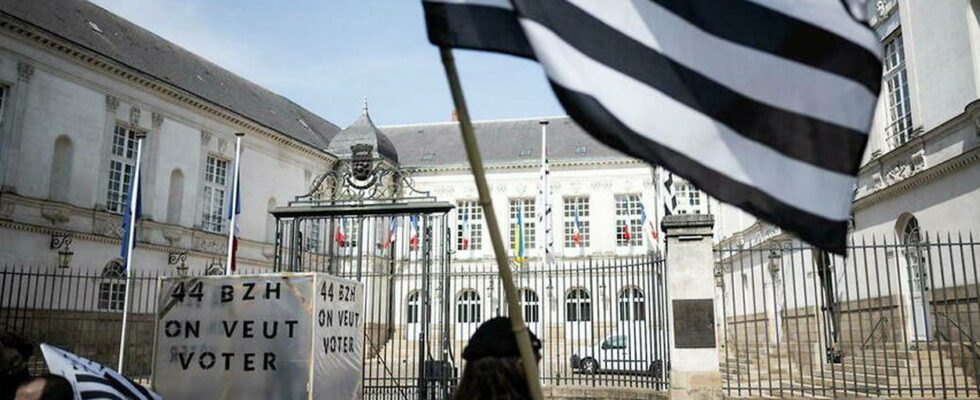IIt was not well seen to be a Breton in France, under the Ancien Régime as under the young Republic… Attached to the kingdom since François Ierthe Grand Duchy carries the image of a backward, distant, inhospitable and barbaric country, recalls the historian Joël Cornette in his new book, A brief history of Breton identity (Tallandier editions).
Himself of Brest origin, this child of the country recounts, with clarity and greed, the long turbulent history of this atypical people, both proud but long ashamed of their roots and their particularities, often mocked by the elite.
Go to India, or almost
A bad image that goes back a long way. Since the Middle Ages, it has been customary to oppose Brittany, independent and wild, to the kingdom of France, a fertile and erudite country, adorned with all the virtues, recalls Joël Cornette.
From the XVe century, even before the Renaissance, pranks given in Paris represent the Bretons barely good at sweeping the streets and cleaning the cesspools, without being able to line up three words of French… Not to mention that, for many, their name rhymes with thief.
Two centuries later, despite the attachment to France, their reputation is still just as mediocre. The Jesuits on mission consider the region almost as an indigenous land, of which the college of Quimper becomes the symbol of local evangelization. Some missionaries evoke “the misery of the Breton people that nothing distinguished from the barbarians, except for its churches and its liturgy”.
For Paris, going to Brittany means going to India, or almost… When King Louis XIII relegates his confessor Nicolas Caussin there, who has become too critical, his relatives compare his exile to a stay “among the Hurons and the Iroquois”. , a country populated by “semi-savages”.
Hostile land and too catholic
The same observation and the same lamentations in the report sent by a finance general to Colbert, minister of Louis XIV, in 1663: barbaric lands everywhere, except for the two bishoprics of Vanne and Saint-Brieuc.
“Almost everyone is rough, rude, ignorant, brutal, it is explained. The same reasons which preserved their value to Caesar’s Gauls maintain roughness, laziness and drunkenness among the Bretons. » Don’t throw any more!
READ ALSO“Regionalist movements create a kind of “Identity Disneyland””
The Revolution hardly changed the situation, on the contrary. Even if a number of Breton deputies actively participated in the change of regime – they notably founded the future club of the Jacobins – the country was quickly perceived by Paris as a hostile and far too Catholic land, populated by obscurantist peasants.
The fault of the Reform of the Church and the levy en masse, which will electrify the campaigns against the capital, giving brittany the image of a country of Chouans, backward and counter-revolutionary, while the movement mainly affected the south and east of the province. Calm will return only under the reign of Bonaparte.
“Good people, but stubborn”
Brittany then entered the 19th century.e century by always dragging its clichés: a backward land with archaic customs, “it looks like a living museum, a repository of objects, customs, clothing, furniture, beliefs, legends”, writes the historian Joël Cornette.
READ ALSO“After the Edict of Nantes, pacified France looks towards the sea”
Gauguin comes to find inspiration there, Flaubert mocks it in his Dictionary of received ideas : “Bretons: all good people, but stubborn”, writes the novelist, who describes groups of beggars always at your heels as soon as you arrive in a place…
Illiteracy reigns supreme, Armorica is the most unschooled French region in the first half of the 19th century.e century. Poverty pushes the inhabitants to join the cities, in particular Paris, to find a salary. It’s the great migration of young girls as maids of all trades, caricatured in the guise of the famous Bécassine, who doesn’t even have a mouth…
Sardine’s Revenge
And yet, there is another Brittany, underlines Joël Cornette, who recalls that the maritime cities showed remarkable vigor from the 16the century, with several hundred small ships that provide fishing and trade with England or Flanders from Penmarc’h, Morlaix or Quimperlé…
Very quickly, Saint-Malo launched its ships out to sea for cod fishing, pushed to the American and Indian shores, grew rich with the activity of the corsairs, Brest took advantage of its naval base and its arsenal and Lorient developed with the establishment of the Compagnie des Indes…
READ ALSOBrittany: an island put up for sale at 1.68 million euros
In the 19the century, the first major industries developed, particularly in Nantes, and canning factories came to energize the entire south coast, from Pornic to Douarnenez.
“In 1880, the Breton canneries were at their peak and France had a virtual world monopoly of the export of sardines in oil, explains the historian. So, rid of stereotypes! »
deep metamorphosis
However, it will be necessary to wait for the XXe century and the 1950s to see Brittany establish itself as a dynamic region, driven by a real industrial revolution in the cities, accompanied by an impressive transformation of the countryside, which made Armorica a great agricultural power.
With this political peculiarity that appeared in the 1970s, when these lands reputed to be backward and traditional voted little by little to the left, as the sign of a profound metamorphosis…
At the same time, Breton pride took on new colors and became fashionable: festivals, Celtic music, language, literature, we rediscovered the secular identity that we carried as a banner. Bécassine finally gets his revenge on the arrogant Paris…
A brief history of Breton identity. From Himilcon to the present day, by Joël Cornette, Tallandier editions, January 2023, 240 pages, 19 euros.
